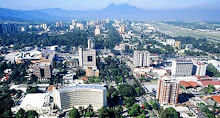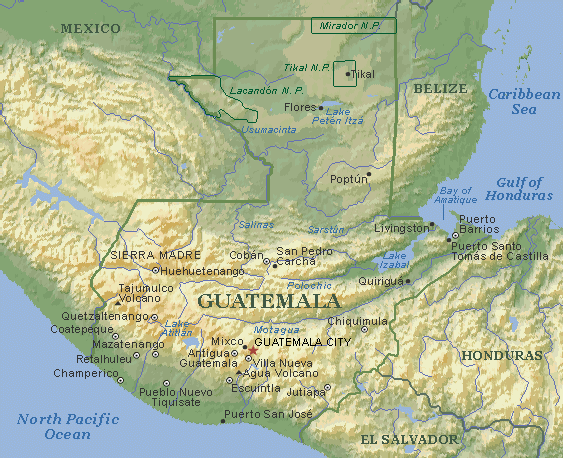First of all, let me tell you where Guatemala is... Guatemala is right below Mexico, the Pacific Ocean to the west, Belize and the Caribbean Sea to the east, Honduras and El Salvador to the southeast. The weather is pretty much steady, there are only two seasons, dry and rainy but either one is pleasant so we call Guatemala the land of eternal spring. The best time to travel is in the dry season that is from October to around May. The temperature is about 77°F in the low lands and jungles and about 55°F in the highlands. The whole country is roughly the size of Tennessee and there is only one major city, Guatemala City, so almost all international flights come here, the airport code is GUA. Guatemala City is a metropolis on its own, you can get almost anything you want, MacDonald's even delivers to your door but like many big city it has its risks so while there stay in the upper scale and touristy areas. The City has a great variety of hotels, restaurants, travel agencies and car rental options. When you fly in from out of the country you can spend a few days here. The center of the city has some really old and beautiful buildings. There is a place called 4° North. This is a pedestrian only part of town that used to be industrial warehouses, now rebuilt and promoted so now you can find cafes with sidewalk tables, live music, all kinds of foods and art all in one plus some of the best night clubs. There is some thing going on all the time.Then you have what we call the "Zona Viva", the live zone. Here is where some of the nicest hotels and restaurants are. This is one of the safest areas of the city. In the city also is the Mayan city of Kaminaljuyu.
We Guatemalans call ourselves "chapines" and this applies to any one from the country but more specifically to some one from Guatemala City. I don't know why so if there is any one there that has a good answer to this please let me know.
This is a link to a view of Guatemala City
http://www.youtube.com/watch?v=E4OS7anYD44
From "In Full Bloom: Square One, Barbados’ contribution to the Advancement of Soca on the World Arena."
Faluma arose while the band was touring Suriname in early 1998. It essentially is a Dutch folk tune, and the band intent on making their audience feel more at home at their concerts decided to sing it, with their own twist of course. The result was a Dutch folk tune sung to a soca beat almost entirely in Dutch. One could probably predict that the song would be, to say the least, well received in Suriname, however who would fathom that a song whose lyrics are virtually incomprehensible unless one is (no pun intended) speaking Dutch.
The answer to this phenomenon (although already seen before with the likes of Macarena by Los del Rios) I believe lies in the beauty of the arrangement.
Faluma starts of slowly with an extended introduction, where lead Alison Hinds repeats affectionately ‘Mama a ye,ye duna’ to the excitement of the crowd. This is done to a backdrop of light keyboard and the rain-like effect of the high hat. At first she sings solo but is then joined by Anderson Armstrong in a seemingly modified call and response section. This builds up a level of excitement and anticipation as a break is introduced where all that is heard is the roar of the crowd. Suddenly, in true soca style Alison yells ‘ Get Ready to wine’ twice warning the crowd of things to come and to prepare for the fever pitch percussion that is about to follow. Simultaneously all of the instrumentation begins with an insanely fast percussion line in quadruple time (4/8). The bass repeats a simple yet catchy riff, while the drum machine plays a seemingly triple time high-hat (playing six beats per bar). An accordion, not a traditional soca instrument is also used which plays an ascending broken chord at the beginning of every third bar. This is probably a typical instrument of the original folk tune and is used brilliantly in this case.
The song is call and response in its entirety in varying forms. Within the verses, the background singers repeat Alison’s lines and so to in the chorus which commences the song the call and response theme is kept, though in another form. Here, Alison sings followed by the background vocals crying “Faluma!”
She uses the bridge in the song to elicit more calls to the crowd to join in the excitement first in Dutch then in English. During the refrain near the end of the song she ‘exits’ singing English in true soca fashion inviting the crowd to wave their hands in the air and party.
By Dentonio Worrell
you can see his whole paper at:
http://www.sinc.sunysb.edu/Stu/dworrell/In%20Full%20Bloom.doc
The answer to this phenomenon (although already seen before with the likes of Macarena by Los del Rios) I believe lies in the beauty of the arrangement.
Faluma starts of slowly with an extended introduction, where lead Alison Hinds repeats affectionately ‘Mama a ye,ye duna’ to the excitement of the crowd. This is done to a backdrop of light keyboard and the rain-like effect of the high hat. At first she sings solo but is then joined by Anderson Armstrong in a seemingly modified call and response section. This builds up a level of excitement and anticipation as a break is introduced where all that is heard is the roar of the crowd. Suddenly, in true soca style Alison yells ‘ Get Ready to wine’ twice warning the crowd of things to come and to prepare for the fever pitch percussion that is about to follow. Simultaneously all of the instrumentation begins with an insanely fast percussion line in quadruple time (4/8). The bass repeats a simple yet catchy riff, while the drum machine plays a seemingly triple time high-hat (playing six beats per bar). An accordion, not a traditional soca instrument is also used which plays an ascending broken chord at the beginning of every third bar. This is probably a typical instrument of the original folk tune and is used brilliantly in this case.
The song is call and response in its entirety in varying forms. Within the verses, the background singers repeat Alison’s lines and so to in the chorus which commences the song the call and response theme is kept, though in another form. Here, Alison sings followed by the background vocals crying “Faluma!”
She uses the bridge in the song to elicit more calls to the crowd to join in the excitement first in Dutch then in English. During the refrain near the end of the song she ‘exits’ singing English in true soca fashion inviting the crowd to wave their hands in the air and party.
By Dentonio Worrell
you can see his whole paper at:
http://www.sinc.sunysb.edu/Stu/dworrell/In%20Full%20Bloom.doc
Faluma Lyrics
Well,
Since Faluma was #1 hit in Guatemala for 49 weeks and every one is looking for the lyrics...
I have no idea what this lyrics mean, they are in a language called Sranan Tongo, which is a slang from Suriname.
Some one sent them to me:
Mama aye ye duna!!!!!!!!!!!
Bacawehfi duna ye ye duna!!!!!!!!!!!!!!
get ready to whine!!
get ready to whine!!
Faluma ding ding ding
Nyama lama ding
cocowe gena
Capasiah gena
Noguweh gena
ding ding ding
Nyama lama ding
Bocaweh gena
Capasiah gena
Doguweh gena
Peepoweh gena
Soma ding ding ding
Nyama lama ding
Mama yeah yeah
Duna mama yea yea
Duna capasakeeya
Bacawehfi na duna yea yea duna
Mama yeah yeah
Duna mama yea yea
Duna capasakeeya
Bacawehfi na yea yea duna
Mama yeah yeah
Duna mama yea yea
Duna capasakeeya
Bacawehfi na yea yea duna
Mama yeah yeah
Duna mama yea yea
Duna capasakeeya
Bacawehfi na yea yea duna
Faluma ding ding ding
Nyama lama ding
Bocaweh gena
Capasiah gena
Noguweh gena
Ding Ding Ding
Nyama lama ding
Bocaweh gena
Capasiah gena
Doguweh gena
Peepoweh gena
ding ding ding
Nyama lama ding
To the moon!!
Hands up hands up
hands up hands up!
Let me see dem hands
Let me see dem hands
A woman a woman
A matie a matie
A lover a lover
Honey bambambam!
Gyal a bambambam!
Sweety bambambam!
Any bambambam!
Since Faluma was #1 hit in Guatemala for 49 weeks and every one is looking for the lyrics...
I have no idea what this lyrics mean, they are in a language called Sranan Tongo, which is a slang from Suriname.
Some one sent them to me:
Mama aye ye duna!!!!!!!!!!!
Bacawehfi duna ye ye duna!!!!!!!!!!!!!!
get ready to whine!!
get ready to whine!!
Faluma ding ding ding
Nyama lama ding
cocowe gena
Capasiah gena
Noguweh gena
ding ding ding
Nyama lama ding
Bocaweh gena
Capasiah gena
Doguweh gena
Peepoweh gena
Soma ding ding ding
Nyama lama ding
Mama yeah yeah
Duna mama yea yea
Duna capasakeeya
Bacawehfi na duna yea yea duna
Mama yeah yeah
Duna mama yea yea
Duna capasakeeya
Bacawehfi na yea yea duna
Mama yeah yeah
Duna mama yea yea
Duna capasakeeya
Bacawehfi na yea yea duna
Mama yeah yeah
Duna mama yea yea
Duna capasakeeya
Bacawehfi na yea yea duna
Faluma ding ding ding
Nyama lama ding
Bocaweh gena
Capasiah gena
Noguweh gena
Ding Ding Ding
Nyama lama ding
Bocaweh gena
Capasiah gena
Doguweh gena
Peepoweh gena
ding ding ding
Nyama lama ding
To the moon!!
Hands up hands up
hands up hands up!
Let me see dem hands
Let me see dem hands
A woman a woman
A matie a matie
A lover a lover
Honey bambambam!
Gyal a bambambam!
Sweety bambambam!
Any bambambam!
Subscribe to:
Posts (Atom)


